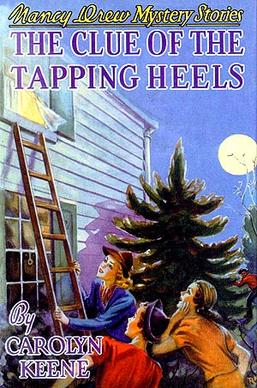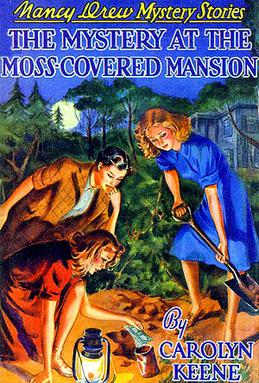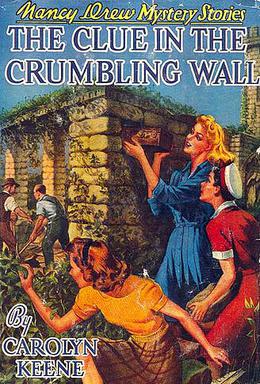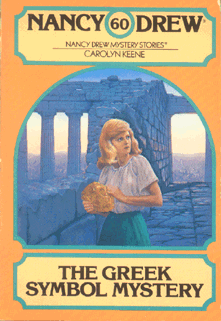
Nancy Drew is a fictional character appearing in several mystery book series, movies, and a TV show as a teenage amateur sleuth. The books are ghostwritten by a number of authors and published under the collective pseudonym Carolyn Keene. Created by the publisher Edward Stratemeyer as the female counterpart to his Hardy Boys series, the character first appeared in 1930 in the Nancy Drew Mystery Stories series, which lasted until 2003 and consisted of 175 novels.

The Secret of the Old Clock is the first volume in the Nancy Drew Mystery Stories series written under the pseudonym Carolyn Keene. It was first published on April 28, 1930, and rewritten in 1959 by Harriet Stratemeyer Adams.

The Secret at Shadow Ranch is the fifth volume in the Nancy Drew Mystery Stories series. It was first published in 1931 under the pseudonym Carolyn Keene, and was ghostwritten by Mildred Wirt Benson. This book, as of 2001, ranks 50 on the list of All-Time Bestselling Children's Books, according to Publishers Weekly, with 2,347,750 sales since 1931.

The Secret of Red Gate Farm is the sixth volume in the Nancy Drew Mystery Stories series, written under the pseudonym Carolyn Keene, It was first published in 1931.

The Clue in the Diary is the seventh volume in the Nancy Drew Mystery Stories series, and was first published in 1932 under the pseudonym Carolyn Keene. Its text was revised in 1962.

Nancy's Mysterious Letter is the eighth volume in the Nancy Drew Mystery Stories series. It was first published in 1932 and was penned by Walter Karig, a replacement writer for Mildred Wirt Benson. Benson declined series work when the Depression forced a reduction in the contract fee provided to Stratemeyer Syndicate writers, so Karig, already an established Stratemeyer writer, took over the authorship. Due to Karig having died in 1956, the 1932 version passed into the public domain in Canada and other countries that have a life plus 50 policy, in 2007.

The Password to Larkspur Lane is the tenth volume in the Nancy Drew Mystery Stories series. It was first published in 1933 under the pseudonym Carolyn Keene. The actual author was ghostwriter Walter Karig in his third and final Nancy Drew novel and his final appearance for the Stratemeyer Syndicate. Due to Karig's death in 1956, this book and his other two Nancy Drews, as of January 1, 2007, have passed into the public domain in Canada and other countries with a life-plus-50 policy.

The Mystery of the Fire Dragon is the thirty-eighth volume in the Nancy Drew Mystery Stories series. It was written under the pseudonym Carolyn Keene, and was first published in 1961.

The Clue of the Broken Locket is the eleventh volume in the Nancy Drew Mystery Stories series. It was first published in 1934 and was written by Mildred Benson under the pseudonym Carolyn Keene. It was later revised by Harriet Stratemeyer in 1965, and the story was mostly changed with a few elements of the original.

The Whispering Statue is the fourteenth volume in the Nancy Drew Mystery Stories series. It was written by Mildred Wirt Benson, whom many readers and scholars consider the "truest" of the numerous Carolyn Keene ghostwriters, following an outline by Harriet Stratemeyer. The book was originally published by Grosset & Dunlap in 1937. An updated, revised, and largely different story was published under the same title in 1970.

The Clue of the Tapping Heels is the 16th volume in the Nancy Drew Mystery Stories series. It was first published in 1939. An updated, revised, and largely different story was published under the same title in 1970. A facsimile edition of the 1939 version was published by Applewood Books. As of 2006, this title is still in print.

The Mystery of the Ivory Charm is the thirteenth volume in the Nancy Drew Mystery Stories series. It was first published in 1936 under the pseudonym Carolyn Keene. The actual author was ghostwriter Mildred Wirt Benson.

The Mystery at the Moss-Covered Mansion is the eighteenth volume in the Nancy Drew Mystery Stories series published by Grosset & Dunlap, and was first published in 1941. The original text was written by ghostwriter Mildred Wirt Benson, based upon a plot outline from Stratemeyer Syndicate co-owner Harriet Stratemeyer Adams. The book's title was changed to Mystery of the Moss-Covered Mansion when it was revised in 1971, because the story is completely different and not much of the investigation takes place at the title location. In the original, many plots and much investigation all tie back to the same house deep in the forest, while Nancy helps her father locate an heiress, expose an impostor, investigate a murder, and look into strange screams at the mansion; none of the action in the original story took place in River Heights.

The Clue in the Crumbling Wall is the twenty-second volume in the Nancy Drew Mystery Stories series. It was first published in 1945 under Carolyn Keene, a pseudonym of the ghostwriter Mildred Wirt Benson.

The Mystery of the Tolling Bell is the twenty-third volume in the Nancy Drew Mystery Stories series. It was first published in 1946 under the pseudonym Carolyn Keene. The actual author was ghostwriter Mildred Wirt Benson.

The Ringmaster's Secret is the thirty-first volume in the Nancy Drew Mystery Stories series. It was first published in late 1953 under the pseudonym Carolyn Keene. The actual author was ghostwriter Harriet Stratemeyer Adams.
Georgia "George" Fayne is a character in the popular Nancy Drew Mystery Stories series. She is one of Nancy's best friends and cousin of Bess Marvin. Her birth name is Georgia, although no one calls her that except her parents.

The Secret in the Old Lace is the fifty-ninth volume in the Nancy Drew mystery series. It was ghostwritten by Nancy Axelrad and first published in 1980 under the pseudonym Carolyn Keene under the Wanderer imprint of Simon and Schuster. It was later republished again in both Wanderer and Minstrel imprints, each time with a new cover. In 2005, Grosset & Dunlap reprinted it in the yellow hardback "glossy flashlight" format. The original edition cover art and six internal illustrations were by Ruth Sanderson. These illustrations were removed in the two subsequent printings.

The Greek Symbol Mystery is the 60th volume in the Nancy Drew Mystery Stories series. It was originally published in paperback in 1981 by the Wanderer imprint of Simon and Schuster. The original edition had a cover and six interior illustrations by Ruth Sanderson. The cover art was later revised by Garin Baker in 1986 for the last Wanderer printing, and again by Linda Thomas in 1989 for the Minstrel printing.

Ransom of the Seven Ships is the 20th installment in the Nancy Drew point-and-click adventure game series by Her Interactive. The game is available for play on Microsoft Windows platforms. It has an ESRB rating of E for moments of mild violence and peril. Players take on the first-person view of fictional amateur sleuth Nancy Drew and must solve the mystery through interrogation of suspects, solving puzzles, and discovering clues. There are two levels of gameplay, Junior and Senior detective modes, each offering a different difficulty level of puzzles and hints, however neither of these changes affects the actual plot of the game. The game is loosely based on a book entitled The Broken Anchor (1983).


















